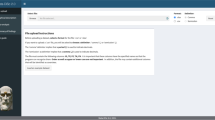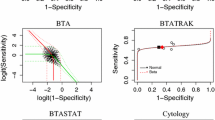Abstract
The validation of diagnostic test meta-analysis is often threatened by publication bias, which can be commonly characterized by the Copas selection model. Under this model, conventional approaches to diagnostic meta-analysis are based on conditional likelihood. Since they may have efficiency loss, we propose a full likelihood diagnostic meta-analysis method by integrating the usual conditional likelihood and a marginal semi-parametric empirical likelihood. We show that the resulting maximum likelihood estimators (MLEs) have a jointly normal limiting distribution, and the resulting likelihood ratio follows a central chisquare limiting distribution. Our numerical studies indicate that the proposed MLEs often have smaller mean square errors than the conditional likelihood MLEs. The full likelihood ratio interval estimators generally have more accurate coverage probabilities than the conditional-likelihood-based Wald intervals. We re-study two real meta analyses on influenza and mental health respectively for illustration.



Similar content being viewed by others
References
Almalik O, Zhan Z, Van den Heuvel ER (2020) Copas’ method is sensitive to different mechaisms of publication bias. arXiv:2007.15955
Carpenter JR, Schwarzer G, Rucker G, Kunstler R (2009) Empirical evaluation showed that the Copas selection model provided a useful summary in 80% of meta-analyses. J Clin Epidemiol 62:624–631
Chartrand C, Leeflang MMG, Minion J, Brewer T, Pai M (2012) Accuracy of rapid influenza diagnostic tests: a meta-analysis. Ann Intern Med 156:500–511
Chootrakool H, Shi JQ, Ronhxian Y (2011) Meta-analysis and sensitivity analysis for multi-arm trials with selection bias. Stat Med 30:1183–1198
Copas J (1999) What works?: selectivity models and meta-analysis. J R Stat Soc Ser A 162:95–109
Copas JB, Li HG (1997) Inference for non-random samples. J Roy Stat Soc B 59:55–95
Copas J, Shi JQ (2000) Meta-analysis, funnel plots and sensitivity analysis. Biostatistics 1:247–262
Copas J, Shi JQ (2001) A sensitivity analysis for publication bias in systematic reviews. Stat Methods Med Res 10:251–265
Deeks JJ, Macaskill P, Irwig L (2005) The performance of tests of publication bias and other sample size effects in systematic reviews of diagnostic test accuracy was assessed. J Clin Epidemiol 58(9):882–893
Duval S, Tweedie R (2000) A nonparametric ”Trim and Fill” method of accounting for publication bias in meta-analysis. J Am Stat Assoc 95:89–98
Egger M, Smith GD, Schineider M, Minder C (1997) Bias in meta-analysis detected by a simple, graphical test. Br Med J 315:629–634
Giuseppe BZ (2018) Diagnostic meta-analysis: a useful tool for clinical decision-making, 1st edn. Springer International Publishing
Glas AS, Lijmer JG, Prins MH, Bonsel GJ, Bossuyt PMM (2003) The diagnostic odds ratio: a single indicator of test performance. J Clin Epidemiol 56(11):1129–1135
Han P (2014) Multiply robust estimation in regression analysis with missing data. J Am Stat Assoc 109(507):1159–1173
Hattori S, Zhou XH (2018) Sensitivity analysis for publication bias in meta-analysis of diagnostic studies for a continuousbiomarker. Stat Med 37:327–342
Heckman JJ (1979) Sample selection bias as a specification error. Econometrica 47:153–161
Li M, Liu Y, Li P, Qin J (2020) Empirical likelihood meta analysis with publication bias correction under Copas-like selection model. Manuscript
Light RJ, Pillemer DB(1984) Summing up: the science of reviewing research. Harvard University Press, Cambridge
Lijmer JG, Bossuyt PMM, Heisterkamp SH (2002) Exploring sources of heterogeneity in systematic reviews of diagnostic tests. Stat Med 21:1525–1537
Mavridis D, Sutton A, Cipriani A, Salanti G (2012) A fully Bayesian application of the Copas selection model for publication bias extended to network meta-analysis. Stat Med 32(1):51–66
Mavridis D, Welton NJ, Sutton A, Salanti G (2014) A selection model for accounting for publication bias in a full network meta-analysis. Stat Med 33(30):5399–5412
Ning J, Chen Y, Piao J (2017) Maximum likelihood estimation and EM algorithm of Copas-like selection model for publication bias correction. Biostatistics 18(3):495–504
Owen AB (1988) Empirical likelihood ratio confidence intervals for a single functional. Biometrika 75:237–249
Owen AB (1990) Empirical likelihood ratio confidence regions. Ann Stat 18:90–120
Piao J, Liu Y, Chen Y, Ning J (2019) Copas-like selection model to correct publication bias in systematic review of diagnostic test studies. Stat Methods Med Res 28:2912–2923
Reitsma JB, Glas AS, Rutjes AW (2005) Bivariate analysis of sensitivity and specificity produces informative summary measures in diagnostic reviews. J Clin Epideimol 58(10):982–990
Rothstein HR, Sutton AJ, Borenstein M (2006) Publication bias in meta-analysis: prevention, assessment and adjustments. Wiley, Sussex
Schwarzer G, Carpenter J, Rucker G (2010) Empirical evaluation suggests Copas selection model preferable to trim-and-fill method for selection bias in meta-analysis. J Clin Epidemiol 63:282–288
Takwoingi Y, Riley RD, Deeks JJ (2015) Meta-analysis of diagnostic accuracy studies in mental health. Evid Based Mental Health 18(4):103–109
Zhou XH, Obuchowski NA, McClish DK (2011) Statistical methods in diagnostic medicine. Wiley, New York
Acknowledgements
Dr. Fan’s research was support by the National Natural Science Foundation of China (11971300) and the Natural Science Foundation of Shanghai (19ZR1420900). Dr. Liu’s research was supported by the National Natural Science Foundation of China (11771144, 11871287), the State Key Program of the National Natural Science Foundation of China (71931004), the development fund for Shanghai talents, the 111 project (B14019), and the Fundamental Research Funds for the Central Universities. The first two authors contribute equally.
Author information
Authors and Affiliations
Corresponding author
Ethics declarations
Conflict of interest
On behalf of all authors, the corresponding author states that there is no conflict of interest.
Additional information
Publisher's Note
Springer Nature remains neutral with regard to jurisdictional claims in published maps and institutional affiliations.
Supplementary Information
Below is the link to the electronic supplementary material.
Rights and permissions
About this article
Cite this article
Li, M., Fan, Y., Liu, Y. et al. Diagnostic test meta-analysis by empirical likelihood under a Copas-like selection model. Metrika 84, 927–947 (2021). https://doi.org/10.1007/s00184-021-00809-2
Received:
Accepted:
Published:
Issue Date:
DOI: https://doi.org/10.1007/s00184-021-00809-2




